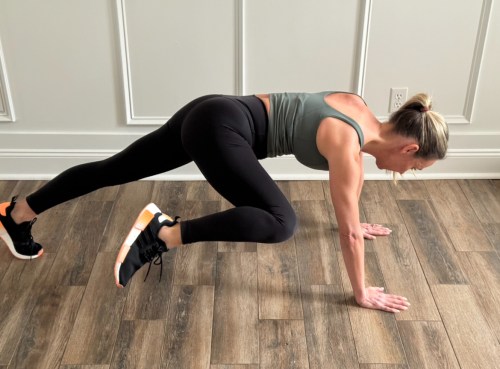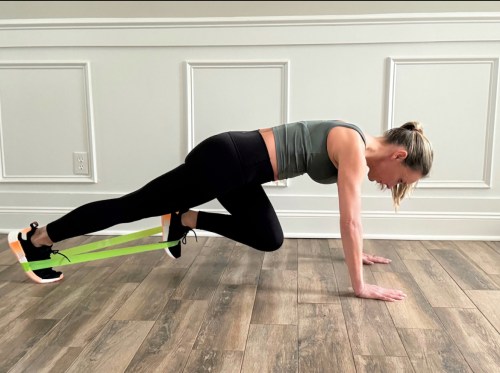Which Muscles Do You Work When You Do Mountain Climbers?
Discover mountain climbers muscles worked. Strengthen your core, upper body, and lower body with this effective exercise.

If the standard plank is starting to get boring, it is time to add mountain climbers into your workout routine. They are an amped-up version of the plank—and no actual climbing experience is required.
Experts in This Article
corrective exercise specialist and founder of Garage Gym Greatness
certified personal trainer and Tonal strength coach
trainer and human performance specialist with Memorial Hermann’s Rockets Sports Medicine Institute
This exercise strengthens your arms, core, and legs. No gym membership? No problem. You can do this move at home without any special equipment.
Mountain climbers are thought to have gotten their start in the military, where they were used to train soldiers how to move quickly while staying low to the ground. This versatile exercise can be used as a warm-up, part of a HIIT workout, or as a stand-alone move to build muscle strength and cardio fitness.
“Mountain climbers are a great full-body workout because they engage the entire body for a high-intensity, low-impact workout,” says Karly Mendez, a trainer and human performance specialist with Memorial Hermann’s Rockets Sports Medicine Institute.
Which muscles do mountain climbers work?
At first glance, the mountain climber exercise look fairly simple. However, this full-body exercise works several muscle groups.
Let’s jump into the specifics of mountain climbers muscles worked.
1. Lower-body muscles
Mountain climbers are a great exercise to strengthen your leg muscles because they require lower-body involvement.
“Your quads and hip flexors help to bring your knee to your chest, while your glutes and hamstrings are activated to extend your legs back,” says certified personal trainer and Tonal strength coach Ash Wilking, CPT.
In addition, your calf muscles are strengthened as you push off to switch legs.
2. Abdominals
Mountain climbers help strengthen your abdominals as well.
“They target your core to stabilize your torso during the movement,” Wilking says.
Mountain climbers also work your obliques (the muscles on the side of your midsection) to assist in the rotation of your torso, she says.
3. Upper-body muscles
Mountain climbers are also effective for upper-body engagement, strengthening your arms, chest, back, and shoulders, particularly your deltoids and triceps. Your upper body helps to stabilize as you perform this move.
How to do a mountain climber
To get the maximum benefits, proper mountain climber form is important. Follow these step-by-step instructions.
- 1.Start in a high plank position with your body in a straight line, your back straight and your shoulders over your wrists.
- 2.Bring your right knee into your chest, keeping your left leg extended behind.
- 3.As you return your right leg to the starting position, switch and bring your left knee into your chest.
- 4.Continue alternating bringing your knees into your chest, ensuring your hips stay down in a plank position.
- 5.If you feel comfortable, you can increase the speed of motion, ensuring proper form is maintained throughout.
- 6.Repeat 2 sets of 10 to 12 reps.
Tip: Start by alternating legs slowly one at a time in a marching motion before building up speed and switching them quickly, like in a running motion.
What are the benefits of mountain climbers?
Now that you know how to do a mountain climber with proper form, let’s discuss why you should do them. Here are a few notable mountain climber benefits.
1. They build full-body strength
“If you’re looking for an exercise to work multiple muscle groups, mountain climbers are perfect for this,” Wilking says. “They target your core, shoulders, arms, and legs to overall strengthen your muscles and get the heart rate up.”
2. They improve cardiovascular endurance
Mountain climbers increase your heart rate to improve both your endurance and your cardiovascular health. You can maximize the cardio benefits of mountain climbers by including them as part of a HIIT circuit, according to Andrew Peak, CPT, corrective exercise specialist and founder of Garage Gym Greatness.
“This might include bursts of reps for time, for example, 20 seconds on and 10 seconds off. This kind of high-intensity training will develop your cardiovascular fitness,” he says, explaining that the exercise on its own would not be as effective. “You definitely need to build it into part of a cardio routine.”
In fact, a small January 2022 study in the Journal of Exercise Science and Fitness found that people who did just 10 minutes of whole-body HIIT training (which included mountain climbers, burpees, jumping jacks, and squats) three times a week improved their cardiovascular function —and potentially reduced the risk of cardiovascular disease.
3. They boost balance and coordination
“The action of putting your weight on one leg at a time helps develop balance and coordination over time,” Peak says.
This is not only beneficial as you get older, but it may also help your performance in certain sports, such as tennis, basketball, and soccer.
4. They’re a low-impact exercise
Mountain climbers are a good choice for those who can’t do high-impact exercises.
“Even though mountain climbers are considered a high-intensity workout, they are low impact, which helps those who may have joint aches and pains,” Mendez explains. (FYI: A low-impact exercise is one where you have at least one foot on the ground at all times, which puts less stress on your joints.)
5. They don’t require any exercise equipment
You can do this exercise at home, at the gym, or even in a hotel room.
“Mountain climbers are convenient and accessible because they require no workout equipment,” Wilking says.
“Mountain climbers are a great full-body workout because they engage the entire body for a high-intensity, low-impact workout.” —Karly Mendez, trainer and human performance specialist
Mountain climber variations to add to your arsenal
There are several modifications of the mountain climber exercise that can make it easier or more of a challenge.
1. Beginner modification: elevated mountain climber
If you can’t maintain proper form with the standard mountain climber, start by using a step to help build up your strength.
“Place your hands on an elevated surface, like a bench or step, to reduce the strain on your wrists—and allow a less intense workout,” Wilking says.

- 1.Place your hands on a step with your legs straight behind you so you’re in an elevated high plank position.
- 2.Make sure your body is in a straight line with your shoulders above your wrists.
- 3.Bring your right knee into your chest, keeping your left leg extended behind.
- 4.As you return your right leg to the starting position, switch and bring your left knee into your chest.
- 5.Continue alternating bringing your knees into your chest, ensuring your hips stay down in a plank position.
- 6.If you feel comfortable, you can increase the speed of motion, ensuring proper form is maintained throughout.
- 7.Repeat 2 sets of 10 to 12 reps.
2. Advanced progression: spider mountain climber
This move, which resembles a spider crawling, targets your obliques and your hip flexors, Wilking says.

- 1.Start in a high plank position with your body in a straight line, your back straight and your shoulders over your wrists.
- 2.Bring your right knee out to the side toward your right elbow. Keep your left leg extended behind.
- 3.Return your right leg to the starting position.
- 4.Bring your left knee out to the side toward your left elbow, keeping your right leg extended behind.
- 5.Continue alternating bringing your knees out to the side toward each elbow.
- 6.As you get comfortable with this motion, you can increase the speed as long as you maintain proper form.
- 7.Repeat 2 sets of 10 to 12 reps.
3. Advanced progression: banded mountain climber
Placing a resistance band around your feet will provide added resistance to help increase your strength.

- 1.Place a looped resistance band around the soles of your feet. You can also place it above your knees if that’s more comfortable.
- 2.Get into a high plank position with your body in a straight line, your back straight and your shoulders over your wrists.
- 3.Bring your right knee into your chest, keeping your left leg extended behind.
- 4.As you return your right leg to the starting position, switch and bring your left knee into your chest.
- 5.Continue alternating bringing your knees into your chest, ensuring your hips stay down in a plank position.
- 6.Keep resistance on the band the entire time.
- 7.If you feel comfortable, you can increase the speed of motion, ensuring proper form is maintained throughout.
- 8.Repeat 2 sets of 10 to 12 reps.
Common mistakes people make when doing mountain climbers
Proper form is important to not only maximize the benefits of mountain climbers but also to prevent injury. Avoid making these three common mistakes.
1. Raising your hips too high
If you don’t have the core strength to perform this move or if you get tired, you may find yourself raising your hips up instead of keeping your body in a straight line.
“You must maintain a plank position to perform the exercise correctly,” Peak says.
2. Dropping your hips or lower back
Your body should stay in a straight line throughout the exercise.
“It’s super important to keep your core engaged—as you get tired, you can start to drop your lower back and fall into a bad position,” Peak says. “If this happens, take a break, refocus, and get back into the plank position with an engaged core.”
3. Improper shoulder placement
Wilking says she often sees people shift their weight back, allowing their shoulders to fall behind their wrists. “We want to keep the wrist and shoulders stacked,” she says.
Pro tips to prevent injury
You should always listen to your body when doing a new exercise. It’s normal to feel your muscles fatigue and get tired, but you should stop if you feel sharp pain. Follow these expert-approved tips to prevent an injury while doing the mountain climber exercise.
- Watch your alignment: “If you can’t do the exercise with the correct form, stop and wind the intensity back,” Peak says. “In this case, I would suggest starting with some basic planks. Do this until you can do at least 60 seconds continuously before attempting mountain climbers again.”
- Avoid wrist pain: “If there’s any pain in your wrists, you can elevate the base of your palms with a folded towel to decrease the angle on the front of your wrists,” Wilking says.
- Keep your elbows slightly bent: “Don’t lock your elbows so that the joints are holding all the pressure. Keeping a micro bend in your elbows can allow the muscles in your arms and shoulders to do all the work—which is what we want,” Wilking says.
- Warm up first: “Make sure you perform at least 5 minutes of light cardio, such as jogging or cycling,” Peak says. “This will ensure your body is primed and ready to roll.”
- Start slow: “If running your legs quickly creates excessive bounce, pain in your shoulders or feet, switch to marching at a quick pace—which can still help elevate your heart rate,” Wilking says.
FAQ
1. Are mountain climbers bad for your knees?
This exercise is actually good for your knees, as it’s a low-impact move that strengthens the muscles that support your knee.
“The majority of your body weight will rest on your hands, which does not put much stress on your knees,” Mendez says.
However, if you have had a previous knee injury or other medical condition, such as a knee replacement, arthritis, or knee surgery, talk to your doctor before doing this exercise.
“Improper form could give you knee issues, but when performed correctly they are unlikely to do so for someone without any pre-existing issues,” Peak says. “If you do have existing knee problems, the repetition could prove problematic. In all cases, you need to listen to your body and stop if something doesn’t feel right.”
2. How many mountain climbers should you do in a day and how long should you spend on them?
“I wouldn’t recommend doing these every day, although you could,” says Peak. “They should be performed as part of a well-rounded fitness routine. I would recommend doing these in high-intensity bursts of 30-second intervals—or as part of a bodyweight circuit. You may also want to pop these on the end of an exercise routine and do three sets of 30, for example.”
3. Can mountain climbers replace running?
Mountain climbers can’t replace running. However, they are still an important exercise for runners.
“I would say that mountain climbers are a great alternative if you don’t have access to a treadmill and can’t get in a run outside—or if someone needs to take some load off their knees or lower body in general,” Mendez says.
But, they can’t replace running in terms of cardio benefits—especially steady-state or sprints, according to Peak.
“While mountain climbers can mimic running patterns, they aren’t a direct replacement,” Wilking says. “However, mountain climbers are a great way to build endurance, overall strength, and core stability to help with running.”
Sign Up for Our Daily Newsletter
Get all the latest in wellness, trends, food, fitness, beauty, and more delivered right to your inbox.
Got it, you've been added to our email list.










